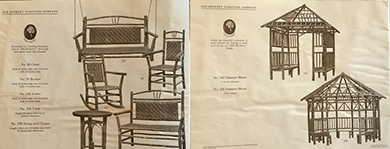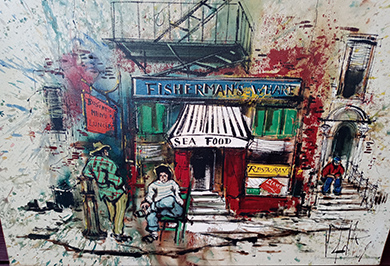 |
|
|||
 |
 |
|||
RINKER ON COLLECTIBLES — Column #1799 Copyright © Harry Rinker, LLC 2021 Questions
and Answers
QUESTION: I have a 1922 Old Hickory Porch and Garden Furniture catalog. It is complete (36 pages) and in fine shape. One page contains pictures of two, open summer houses – one square and the other octagonal shape. I also have a 1932 price list. What is the secondary market value of the catalog and price list? – SK, Meridan, ID, Email Question 
ANSWER: In order to assess the value of your catalog, I checked two things. First, I wanted to determine if the catalog had ever been reprinted and, if so, how recently. A reprint of the 1922 catalog was included in Ralph Kylloe’s “Indian Hickory Furniture,” published by Rustic Publications of Nashua, New Hampshire in 1988. A seller on Abebooks.com is asking $80.00, shipping included, for a copy. I found no other reprints. Second, I checked to see if the catalog was part of any library holdings. The Adirondack Experience Museum on Blue Mountain Lake has a copy in their collection. Although I did not find references to the catalog being in other libraries, there has to be several. A safe conclusion is that the catalog, especially complete and in fine condition, is scarce. There are two value questions. The first is how to maximize the value of your catalog. The second is what is it worth if you sell it. The answer to the two questions is not the same. I am an entrepreneur. If I owned your catalog, I would explore methods to maximize its value before considering selling it. Thanks to digital age scanning and on demand printing, it is relatively inexpensive to prepare reproductions of the catalog and offer them for sale on eBay and other internet websites. You might even consider jobbing them to historic sites and museum shops that specialize in Arts and Crafts and Adirondack reference material. If you do your homework, you should be able to reprint the catalog, including its colorful cover as part of the reprint, for under five dollars a unit. If you retail them at $30.00, you can wholesale them to the shops for $15.00 and still make a nice profit. If you adopt my approach, take one additional piece of advice. Do not get greedy. It is possible to push the retail price of the reprint beyond $30.00. Such an approach will reduce sales. The more affordable you make the catalog reprint, the more you will sell. I did find an example of the 1922 catalog on WorthPoint.com’s Worthopedia. An example sold on eBay for $128.49 on March 4, 2011. A 1930 Old Hickory Porch and Garden Furniture catalog sold for $227.50 on eBay on September 19, 2016. Given the scarcity and condition of your catalog, I recommend a minimum asking price of $250.00. Include the 1932 price list as part of the sale. 
QUESTION: I recently became involved in a “What’s It” question about the use of a handled lidded pan. The pan and handle are made of brass. The lid had filigree metal corners. A central vine motif had what appears to be glass jewels incorporated in the design. The group concluded that the device was a silent butler. Do you agree? – DH, Altoona, PA, Email Question 
ANSWER: A silent butler, also known as an ash butler, is a small container with a handle and hinged cover used to collect ashes or crumbs. They were common from the early 20th century through the 1960s. My parents had a hammered aluminum silent butler. My father was a three pack a day man, meaning the ashtrays in the living room and elsewhere in the house always were filled with cigarettes ashes and butts. When guests were coming, especially unexpected ones, I often was assigned the task of rushing through the house emptying the ashtrays into the silent butler. My mother also belonged to several card clubs. When the ladies met at the house, the silent butler was used to empty the individual ashtrays that were found on the card tables. At the time, ladies smoked almost as much as men. While living in Vera Cruz [PA], I assembled a modest collection of silent butlers. I always associated the form with a slightly tapered deep bowl beneath the hinged lid. When examining the image that accompanied the email, the lid slopes toward the front lip of the base. As a result, it most likely began life with a different purpose. My guess is the device is a crumber, a tool used to remove crumbs from a tablecloth. Although I grew up in a middle-class home, a crumber was an essential tool in my family dining rooms. My parents established housekeeping in the late 1920s. Our dining room was for “formal” family gatherings. At the end of the main course, my mother used the crumber to remove any debris from the dining room table before serving dessert. A crumber consisted of two parts – a brush to gather the crumbs and a tray or pan into which to sweep them. Crumbers were often ornate and elegant in appearance, thus my argument that the device in question more closely fits that of a crumber than a silent butler. [Author’s Aside: The modern crumber tube, used in most upscale restaurants today, was invented in 1939 by John Henry Miller, owner of a West Fayette Street restaurant in Baltimore. Designed to be carried in a waiter’s pocket, it was more convenient and less conspicuous than the pan and brush. Miller received a patent in 1941 and a second in 1946. He eventually sold his patents to the Ray Machine of Baltimore. Ray Machine continues to manufacture the Miller crumber, making approximately 85,000 units a year.] Like so many objects, the initial use of this object has been lost over time. If a “Rinker on Collectibles” reader wishes to join in the debate, email your thoughts to harrylrinker@aol.com. QUESTION: A long time ago, I purchased two paintings at an estate sale. The seller told me they were valuable. The first painting features a newsstand, possible in New York since a street sign reads “Broadway.” The second painting focuses on a restaurant with a sign reading “Fisherman’s Wharf.” While one’s first thought is San Francisco, the location could be anywhere. The technique is crude realism with thick brush paint strokes creating an almost three-dimensional look. I tried without success to figure out the artist signature. Any help you can provide would be appreciated. – JS, Howey in the Hills, FL 
ANSWER: Do not frustrate yourself. You will never figure out who the artist is. The signature is a pseudo-signature. These two paintings are inexpensive assembly line artwork produced solely for decorating purposes in the 1960s or early 1970s. While it would be nice to assume that antique and collectibles authentication is scientifically and researched based (a good portion of it is), there is a percentage that is guesswork based on past experiences and memories. I like antiques and collectibles that “speak decade,” that is to say, when one sees them, one immediately thinks 1950s, 1960s, 1970s, and so forth. Having lived through the 1960s and blessed with a good memory, your two paintings sing 1960s. I remember seeing almost identical artwork in early Big Box stores such as Almart (Allied Stores) and K-Mart. Similar artwork also was sold in discount, middle-range department stores and souvenir shops on ocean front boardwalks and mountain resorts. The paintings were done in an assembly line fashion. Each artist was assigned a particular part of the painting. By the time the process was finished more than a dozen different artists worked on a single canvas. Compare the two signatures. No two signatures are identical. Artists are the exception. Most artists use the same signature throughout their career. The two signatures on your paintings do not share enough similarities. Your paintings have decorative but no collecting fine art value. The theme and technique are out of fashion in 2020. If you enjoy them, keep them. If you find someone who will pay more than $50.00 for one of them, kiss the hand and take the money. Harry L. Rinker welcomes questions from readers about
collectibles, those mass-produced items from the twentieth and twenty-first centuries.
Selected letters will be answered in this column.
Harry cannot provide personal answers.
Photos and other material submitted cannot be
returned.
Send your questions to: Rinker on Collectibles, 5955 Mill
Point Court SE, Kentwood, MI 49512.
You also can e-mail your questions to
harrylrinker@aol.com.
Only e-mails containing a full name and mailing address
will be considered.
|
||||